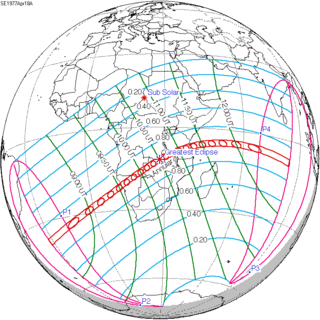| Solar eclipse of April 18, 1977 | |
|---|---|
| Type of eclipse | |
| Nature | Annular |
| Gamma | −0.399 |
| Magnitude | 0.9449 |
| Maximum eclipse | |
| Duration | 424 s (7 min 4 s) |
| Coordinates | 11°54′S 28°18′E / 11.9°S 28.3°E |
| Max. width of band | 220 km (140 mi) |
| Times (UTC) | |
| Greatest eclipse | 10:31:30 |
| References | |
| Saros | 138 (29 of 70) |
| Catalog # (SE5000) | 9458 |
An annular solar eclipse occurred at the Moon's descending node of orbit on Monday, April 18, 1977,[1] with a magnitude of 0.9449. A solar eclipse occurs when the Moon passes between Earth and the Sun, thereby totally or partly obscuring the image of the Sun for a viewer on Earth. An annular solar eclipse occurs when the Moon's apparent diameter is smaller than the Sun's, blocking most of the Sun's light and causing the Sun to look like an annulus (ring). An annular eclipse appears as a partial eclipse over a region of the Earth thousands of kilometres wide. Occurring about 3.1 days before apogee (on April 21, 1977, at 13:00 UTC), the Moon's apparent diameter was smaller.[2]
Annularity was visible in South West Africa (today's Namibia), Angola, Zambia, southeastern Zaire (today's Democratic Republic of Congo), northern Malawi, Tanzania, Seychelles and the whole British Indian Ocean Territory. A partial eclipse was visible for parts of eastern Brazil, Southern Africa, Central Africa, East Africa, Antarctica, the Middle East, and South Asia.
- ^ "April 18, 1977 Annular Solar Eclipse". timeanddate. Retrieved 8 August 2024.
- ^ "Moon Distances for London, United Kingdom, England". timeanddate. Retrieved 8 August 2024.
